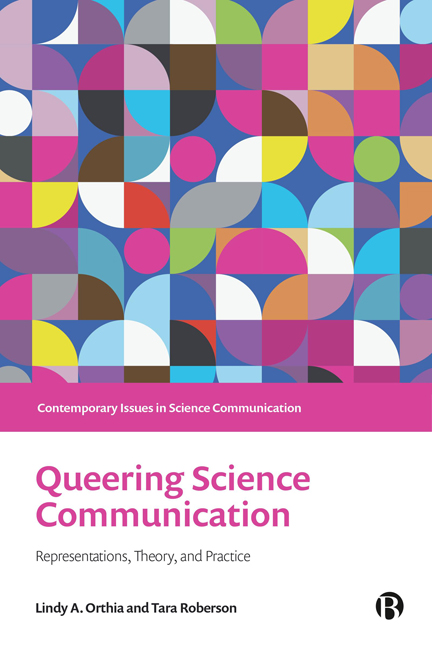Book contents
- Frontmatter
- Contents
- Series Editor Preface
- Notes on Contributors
- Acknowledgements
- Terminology and Sensitive Content in This Book
- Introduction
- PART I Negotiating Queer Identities with Science, Technology, and Medicine
- PART II Representations of Queerness in Public Science Communication
- PART III Queer People in Science Communication Communities
- PART IV Queering Institutional Science Communication Agendas
- Conclusions
- Index
1 - Where to ‘Keep’ the Queer: Contestations and Anxieties in Clinical Communications
Published online by Cambridge University Press: 18 January 2024
- Frontmatter
- Contents
- Series Editor Preface
- Notes on Contributors
- Acknowledgements
- Terminology and Sensitive Content in This Book
- Introduction
- PART I Negotiating Queer Identities with Science, Technology, and Medicine
- PART II Representations of Queerness in Public Science Communication
- PART III Queer People in Science Communication Communities
- PART IV Queering Institutional Science Communication Agendas
- Conclusions
- Index
Summary
Given its inevitable influence in all stages of our lives, medical discourse is a significant form of public science communication and one that is especially relevant to queer people. Queerness has often been included within dominant discourses of pathology in public medical discourse and queer people have been at the active receiving end of this institutionalized oppression. For instance, the implicit assumption of cis-heterosexuality as the by default biological/clinical norm continues to otherize and alienate queer people in various capacities in clinical communications. This of course runs hand in hand with cissexist and heterosexist societal values that are mirrored by major social institutions of medicine, law, heteronormative family structures, and religion.
In this chapter, I examine the construction of queer identities in clinical communication along two distinct disciplinary trajectories: first, the framing of queerness as mental illness by the mental health sciences; and second, the idea of ‘risky sexuality’ in public health discourse centring the AIDS epidemic. It is convenient and tempting to see clinical communications arising out of public medical discourse as inarguable facts that are objective, neutral, and apolitical. Yet histories of knowledge production regarding queer identities in clinical disciplinary frameworks speak otherwise. This will be my central argument in this chapter. In this context, I will be looking at the evolution of clinicians’ characterizations of ‘homosexuality’ from a site of pathology to a normal variant of human sexuality. I will also be taking note of the radical shift in clinical communications from pathologizing of transgender identities to acknowledgement of the gender spectrum and the diversity of gender identities, expressions, and experiences. For transgender individuals, the current clinical consensus is focused on alleviating dysphoria or distress (if any) due to felt incongruence between their sex-assigned-atbirth and experienced gender.
With changing frames of clinical understandings, the reference points for what constitute the binaries of the ‘clinically normative’ and the ‘deviant’ subjects also keep shifting. This shift has massive implications for it is accompanied by rapidly changing frameworks of care. ‘Conversion’ of queer individuals to compulsory cis-heterosexuality was once recognized as ‘cure’ and now the same has been discredited by major mental health professional bodies around the world.
- Type
- Chapter
- Information
- Queering Science CommunicationRepresentations, Theory, and Practice, pp. 17 - 31Publisher: Bristol University PressPrint publication year: 2023

